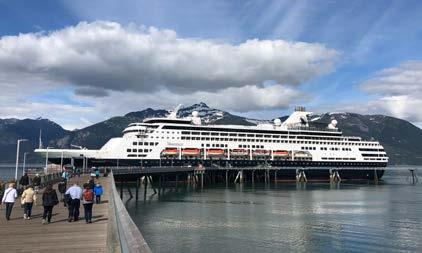
12 minute read
Health Watch
Throwing Shade
Too Much Sun is Just No Fun.
Advertisement
By Robin Stoloff
Unless you have been living in a cave (in which case you do not need this article), you have undoubtedly heard of the benefits of reducing sun exposure and using sunscreen. However, just like everything else we know is good for us, we don’t always do it, or we don’t do it correctly. In addition to fine lines, wrinkles, and leather-like skin, too much sun can lead to skin cancer, the most common type of cancer in the United States.
Some people think about sun protection only when they spend a day at the lake, beach, or pool. However, sun exposure is cumulative, and it happens every time we are in the sun. Our skin remembers every minute of sun exposure, so wearing sunscreen every day should be a crucial part of our skincare routine. Fortunately, there are a variety of great moisturizers that contain sunscreen for everyday use. Even on cloudy days, ultraviolet rays can damage our skin. While some UV rays can also pass through windows in our car, home or office, it probably does not pose a significant risk to most people unless they spend long periods close to a window that gets direct sunlight.
Sunscreens are available in many forms — lotions, creams, ointments, gels, sprays, wipes, and lip balms, to name a few. When choosing a sunscreen, be sure to read the label. Look for sunscreens with broad-spectrum protection (against both UVA and UVB rays) and with sun protection factor (SPF) values of 30 or higher. It is important to note that higher numbers do make a huge difference in protection. The higher you go, the smaller the difference in protection and most experts say an SPF of 30 is sufficient.
Sunscreen is only as effective as how we use it. Many people will apply a small amount of sunscreen when they first go to the beach. They go in the water, they sweat, and they forget to reapply it. You can’t just slather yourself with sunscreen in the morning, head out for a long day at the beach or pool and expect to come home sunburn-free. Most experts recommend reapplying sunscreen every two hours. Remember the phrase “Redo in Two.” However, if you are sweating or swimming, you need to reapply more often. Don’t forget your ears, top of your feet, back of your hands and nose.
There are two basic types of sunscreens, chemical and physical. Chemical sunscreen absorbs into the skin and then absorbs UV rays, converts the rays into heat, and releases them from the body. The active ingredients in chemical sunscreens include avobenzone, octinoxate, and oxybenzone. Physical sunblock sits on top of the skin and reflects the sun’s rays. The minerals titanium dioxide and zinc oxide are the main active ingredients in physical blocks.
Physical sunblock tends to be less irritating and better for sensitive skin, but it could be more challenging to blend into the skin. We all remember seeing lifeguards with the white noses! However, newer brands now offer matte and tinted versions that blend more easily. Chemical sunscreen could be a better option if you are swimming or sweating and need a water-resistant formula. It also absorbs more quickly into the skin.
Another important way to limit exposure to UV light is to limit exposure to the sun between the hours of 10 AM and 4 PM when UV light is most potent. To see how intense the sun’s rays are, use the shadow test — if your shadow is shorter than you are, the rays of the sun are strongest.
Clothes also provide different levels of UV protection. Choose long-sleeved shirts, long pants, or long skirts that cover the most skin and are the most protective. Select dark colors that often offer more protection than light colors. A tightly-woven fabric protects better than looselywoven clothing, and dry fabric is generally more protective than wet fabric. Be aware that covering up doesn’t block out all UV rays. If you can see light through a material, UV rays can get through.
Today, new fabrics make it possible for clothing to be lightweight, comfortable, and protect against UV rays even when wet. This type of clothing tends to be more tightly woven, and some have special coatings to help absorb UV rays. These protective clothes often have labels listing the UV protection factor (UPF) value, which is the level of protection the garment provides from the sun’s UV rays on a scale from 15 to 50+. The higher the UPF, the higher the protection from UV rays.
Just as we need sunscreen to protect our skin, we also need UV-blocking sunglasses to protect our eyes and the delicate skin around them. Sunglasses do not have to be expensive; they simply need to block 99 to 100% of UVA and UVB rays. Labels that say “UV absorption up to 400 nm” or “Meets ANSI UV Requirements” mean the glasses block at least 99% of UV rays. Those labeled “cosmetic” block only about 70% of UV rays. If there is no label, don’t assume the sunglasses provide any UV protection.
As the weather warms up and days get longer, we will be spending more time outdoors. Be sure to protect yourself every day by using sunscreen, wearing hats and protective clothing, and limiting sun exposure. By taking some simple steps, we can reduce our risk of wrinkles and lines, sun damage, and most importantly, skin cancer. n
Too much exposure to UV rays can be harmful to our skin, the largest organ in our body, but we don't have to avoid the sun altogether. The American Cancer Society offers an easy way to remember to protect ourselves from the harmful rays of the sun — Slip! Slop! Slap! Wrap!

• SLIP on a shirt. • SLOP on sunscreen. • SLAP on a hat. • WRAP on sunglasses to protect the eyes and skin around them.
Whether you choose a physical or chemical sunscreen, here's what to look for:
• Broad-spectrum (protects from both UVA and
UVB rays) • Fragrance-free • Noncomedogenic (won't clog pores) • Oil-free • Paraben-free • SPF of at least 30 or higher

5Star proudly supports Forza Insurance’s policy holders during Covid-19 and into the future.

Family Protection Plan
Our flagship term product is level to age 121 and stocked with key benefits that set you apart in the marketplace.
Basic Life and AD&D
An important building block to a comprehensive employee benefit program, basic life and AD&D insurance, provides valuable protection for your employees should the unexpected happen.
Healthcare Indemnity
Healthcare Indemnity supplements existing medical coverage by filling the gaps created by rising deductibles, increasing co-payments and higher out-of-pocket maximums.
Group Critical Illness
Our employer paid Group Critical Illness product pays up to THREE (3) times the policy benefit amount.
Group Accident Insurance
Supplemental primary medical insurance with our Group Accident Plan - providing cash benefits from day one with no required coordination of benefits.
The 5StarLife Insurance Company (5Star Life) has a proud and unique heritage as a related enterprise of the Armed Forces Benefit Association (AFBA). The Armed Forces Benefit Association (AFBA) is a not-for-profit association established in 1947 to promote the general welfare and economic interests of military families during war and peace. Over time, we have expanded membership eligibility to also serve federal government employees and contractors, as well as first responders - law enforcement, firefighters, and emergency medical personnel.

The snow covered winter mountains and glaciers are seen from a Cruise Ship.
Amazing Alaska
Travel to the Last Frontier and experience the adventure of a lifetime.
By Albert Ringewald
Holland America’s Maasdam at a port in Haines, Alaska


Tramway in Alaska
Alaska is a land of stories, amazing stories that will stretch your imagination to its limits. Alaska is America, but not the America most of us in the lower 48 know about. Alaska is a grand place, a territory more than twice the size of Texas. Here you can hear stories of survival of gold prospectors who dreamed of quick riches, but more often surren dered to drink and the entrepreneurial companions who comforted them. You will hear native stories that trace their history which are told, many
An aerial view of the Homer Spit, a 4.5 mile long gravel bar that extends into the bay

Change Your Life!

FREE 21 DAY TRIAL MEMBERSHIP Including 1 FREE Personal Training Session (No Purchase Required)
Call 609-487-4650 • MatrxxFitness.com 801 Boardwalk • Atlantic City NJ (at the Showboat Hotel) Local residents only. Must be 25 years or older. See club for details. Limited time offer.
MICHAEL A. GOLOFF Certified Public Accountant

609-350-6958 1616 Pacific Avenue, Suite 407 Atlantic City, NJ 08401
times over, in the meeting house, over the long dark winters. It is during these times that future storytellers are selected among the youth based on their abil ity to accurately retell these tales. This is quite an honor to be chosen to be the keeper of the clan’s history. You will hear their story of how light came into the world, and why the Eagle and the raven are at the core of their culture. When vis iting Alaska, you need to bring a sense of adventure and a will ingness to be surprised. If you do, you won’t be disappointed. These stories are not only passed along orally but, if you have the knowledge, can be deciphered from the totems, tribal para phernalia, meticulously carved masks, even the brightly col ored garments worn for dance and ancient ceremonial practice. Many of these stories tell of seeming impossible moments of survival against animal at tack, the extreme and sudden changes in weather or terrain, or more often, simply get ting lost in the vast wilderness. One year, I heard about a local writer, Lyn Schooler, in Ju neau, who had written a popular book of the region called The Blue Bear. You could find this book in every local bookstore, usually displayed in the win dow. I learned he lived on the outskirts of town and my friend said they sometimes got togeth er, and I asked if I could join them. Schooler was something of a local celebrity; a handsome, wiry man whose face and hands betrayed his years at sea operat ing a charter boat for world-class photographers. He autographed
his book for me and I carried it like a secret treasure; as if I’d come upon a nugget of gold which brought the ear ly settlers to the area, including one Joe Juneau a mostly-drunken prospector af ter whom the town acquired its name. When visiting Southeast Coastal Alaska, you’ll encounter the strong cul tural presence of the indigenous Tlingit. Their colorful clothing, carving, and weaving practices will entrance you, as will their storytelling and mythol ogies. Every Tlingit child will hear the stories of creation, or how “light” came into the world during those long, dark winter nights in the meeting house. In many coastal towns, there are numerous totems standing as testimo ny to the original settlers. The Tlingit and their southern cousins are the only groups that carve totems and, unlike the conclusions of the first white set tlers, they were not intended for religious worship; rather they tell the histories of the clans. When I spoke with master carver Nathan Jackson, a Raven Chilkoot Tlingit who lives a few miles south of Ketchikan near “the end of the road”, he revealed that he receives re quests for totems from all over the world. These totems can take up to two years to carve (the cedar must be “ready”) and he will charge upwards of $70,000, depending on the size, for each one.
I recommend the following as some of the best tours I’ve taken in Alaska:
• One of the best ways to get around in the vast territory of Alaska is by seaplane. Wings Airways (wingsair ways.com), out of Juneau, provides one of the best seaplane tours to Taku Glacier Lodge, an original wil derness cabin nestled near a glacier. You will receive a bird’s eye view of the 1,500 square-mile Juneau ice fields and might see a moose leisurely grazing during flyover.

• In Sitka, there are many exceptional land and marine tour operators. My favorite is the Sea Otter and Wildlife Quest offered by True Alaskan Tours (truealaskantours.com) where you are sure to see humpback whales summering in the plentiful waters off Sitka, to eagles, porpoises, otters, puffins, and bear. If you’re lucky, you might see the humpbacks co operatively “bubble” feeding. Also one of my favorites are the stun ning totems situated in the forest around the Sitka National Historic Park, a short walk from downtown. True Alaskan Tours also offers half-
Season 38 A Season of Hope


starts September 2020
Tickets On Sale Now acballet.org

day salmon fishing tours.
• In Juneau, the Mt. Roberts Tramway is a must. Located just south of downtown, the native owned tram will take you nearly 4,000 ft. above Ju neau to a restaurant, theater, shops, and nature center. Don’t miss the award-win ning, native produced film shown hourly throughout the day. For the more adven turous, there are three wellmarked hiking trails above the restaurant for any level hiker. Bring your raingear as it is often wet in the summer.
• Homer, Alaska is known as the “Halibut Fishing Capital of the World.” Located about 200 miles southeast of An chorage, it’s also nicknamed the “end of the road” and more recently “the cosmic hamlet by the sea.” Its distin guishing feature is the Homer Spit, a 4.5 mile long gravel bar that extends into the bay. Also located on the “Spit” is Homer Harbor, the home of numerous charter fish ing boats for hire. You may not land a 500 lb. halibut, but you’re likely not to re turn empty-handed. Be sure to stop by the Salty Dawg Saloon where folks from all over the world have left their autographed dollar bills that cover nearly every inch of the walls. You’ll feel like a native Alaskan at the Salty Dawg.
You will hear many fascinating stories in Alaska, but only if you are patient and listen. n










